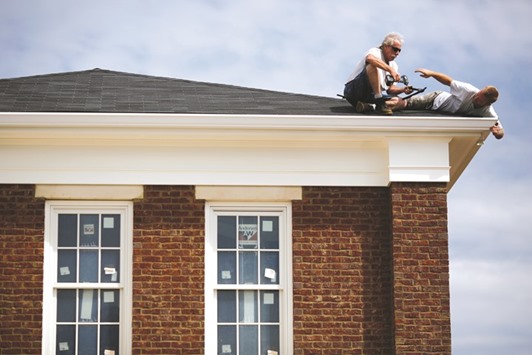New-home construction in the US unexpectedly fell in September on a plunge in multifamily building while permits rose more than forecast, in signs of fitful progress in residential real estate.
Residential starts declined 9% to a 1.05mn annualised rate, the lowest since March 2015, a Commerce Department report showed on Wednesday in Washington. The median forecast of economists surveyed by Bloomberg called for a rise to 1.18mn. Permits, a proxy for future construction, jumped 6.3% to the fastest pace since November.
Faster wage growth and broader access to credit would baoost sales and encourage homebuilders to break ground on more houses, while a shortage of workers may be holding back construction in some areas. At the same time, strong hiring and mortgage costs near historically low levels suggest that the housing recovery will continue despite monthly volatility.
“New-home construction seems to be in a holding pattern,” Jacob Oubina, senior US economist at RBC Capital Markets in New York, said before the report. “But I don’t think the housing recovery per se is stalling out.”
Work on multi-family homes, such as townhouses and apartment buildings, slid 38% to an annual rate of 264,000. Data on these projects, which have led housing starts in recent years, can be volatile. Starts on structures with at least five units were the lowest since June 2013.
Estimates for total housing starts in the Bloomberg survey of economists ranged from 1.1mn to 1.2mn. The previous month was revised to 1.15mn from a 1.14mn pace.
Permits increased to a 1.23mn annualised rate. They were projected to rise to a 1.17mn pace after 1.15mn the prior month, according to the survey.
Single-family house construction rose 8.1% to a 783,000 rate, the most since February, from 724,000 the previous month.
Three of four regions posted a decline, led by the Northeast with a 36% drop, the report showed. Starts in the West were unchanged.
The National Association of Home Builders/Wells Fargo index of homebuilder sentiment eased in October from an 11-month high in the prior month, figures showed on Tuesday. A measure of the six-month outlook for sales climbed to the highest in a year.
Prospective buyers, while benefiting from low borrowing costs, are finding credit isn’t easily accessible across the board and there aren’t enough affordable properties to choose from. On the supply front, builders have said construction is being constrained by the limited availability of lots that are ready for building, and a shortage of skilled workers.
Residential real estate investment accounts for about 3% of gross domestic product.
Jobless claims rise after falling to four-decade low
Bloomberg/Washington
Filings for US unemployment benefits rose last week by the most since July, after spending several weeks at or near a four-decade low.
Jobless claims increased by 13,000 to 260,000 in the period ended October 15, a Labor Department report showed yesterday in Washington. The median forecast in a Bloomberg survey of economists called for 250,000. Continuing claims also rose, though the four-week average was the lowest since 2000.
Hurricane Matthew may have accounted for some of the claims, with several affected states showing a rise in filings before seasonal adjustments. Business owners are generally resisting firing workers as economic growth steadies and the number of skilled candidates diminishes. Even with the increase, filings have been below 300,000 for 85 straight weeks – the longest streak since 1970 and a level typical for a healthy labour market.
Estimates in the Bloomberg survey ranged from 235,000 to 300,000. The Labor Department revised the prior week’s reading to 247,000 from an initially reported 246,000.
The four-week average of claims, a less-volatile measure than the weekly figure, increased to 251,750 from 249,500 in the prior week.
The number of people continuing to receive jobless benefits rose by 7,000 to 2.06mn in the week ended October 8. The unemployment rate among people eligible for benefits held at 1.5%. These data are reported with a one-week lag.
No states had estimated claims last week and there was nothing unusual in the data, according to the Labor Department.
Economists at Goldman Sachs Group had projected a 10,000 gain in jobless claims as workers displaced by Hurricane Matthew began to file. Bank of America Merrill Lynch estimated a total figure of 300,000 for initial claims; the next-highest estimates were for 260,000.
The storm moved up the Florida coastline on October 7 before making landfall in South Carolina the following day and continuing on to North Carolina, causing flooding and power outages along the way.

Contractors install gutters on a house under construction in the Norton Commons subdivision of Louisville, Kentucky. Residential starts declined 9% to a 1.05mn annualised rate, the lowest since March 2015, a Commerce Department report showed in Washington yesterday.
